Japanese the Game is a card game idea that began on Kickstarter in early 2014 with a goal of $5700. By the end of the campaign, it raised $128,808. Obviously, a lot of people thought this was a great idea and wanted to learn Japanese with a card game. Over a year later, Japanese the Game (abbreviated as JTG) has a core deck and 6 expansion decks for sale. With so much content, it surely must teach something. Tofugu got a core and expansion deck so we could experience the hype for ourselves.
Is this game worth $128,000? Or more importantly, does it teach you Japanese?
The Rules

Before you can start playing JTG (or any game), you need to understand the rules. Unfortunately, the rules of Japanese the Game are difficult to understand, though I can’t fault the game for this too much. Cramming all the intricacies of the Japanese language into 2 pages (front and back) of rules is no easy task, and JTG makes a valiant effort.
JTG’s core deck has 72 cards total:
- 16 Particles
- 13 Verbs
- 20 Nouns
- 5 Adverbs
- 7 Adjectives
- 6 Copulas
- 2 Conjugation
- 2 Conjugation Table Cards
- 1 Info Card
To play, each player must have at least 25 cards available to them. Players draw six cards at a time and place predicates to make a sentence. Predicates, according to JTG, are verbs, adjectives, and noun + copula combinations. In your turn, you can lay down predicates and link other parts of speech to them freely, until you decide you’re done. If you want to discard and draw a new card, this will also end your turn.
Each card has a point value. When all point values on the cards making up your sentences equal 20, you’ve won.
The difficulty of JTG’s rules comes in when you practically try and lay cards down. Cards are color-coded and must only be attached to other cards of certain colors, and those combinations must only be laid down in a certain order. JTG offers a handy visual chart to help players understand what goes where when.

But the color order doesn’t always help. For example the sentence “猫を行く” is technically correct according to the color chart, though it’s not correct in Japanese. JTG does tell the player that this is incorrect, but in a very cryptic way. The “行く” card has a the を connector symbol marked out, indicating that you can’t connect を to 行く. This tells you what is incorrect, but does not teach you what grammar would be correct instead. The only reason I know that 行く takes に or へ is because I already know it. How would a beginner, who this game is made for, know that without being told?
Playing the Game
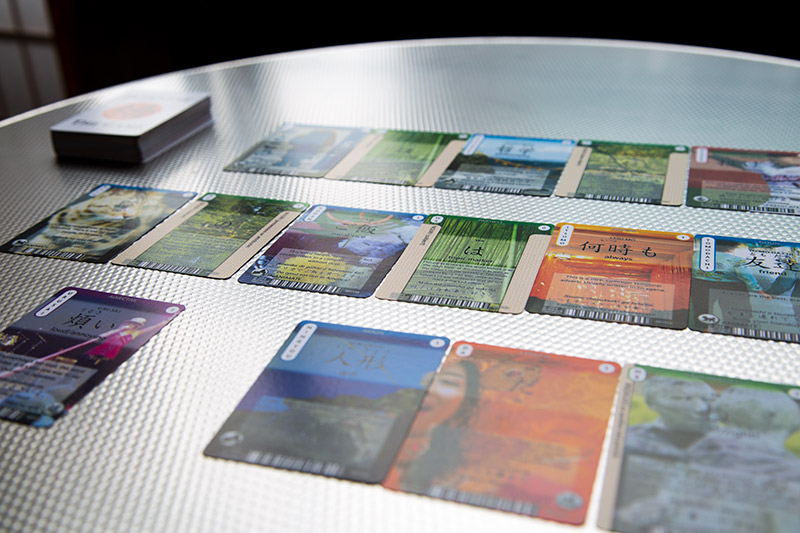
When I sat down to play the game with Tofugu’s own Kristen, I went in ready to play, learn, and have a good time.
In the first round, I drew six cards and immediately laid down predicates. Kristen drew 4 particles and two nouns, so she could do nothing. As I laid down my cards and built my sentences, Kristen continued to draw all particles, unable to play anything in her hand. This continued until I won.
How did I win? With around 16 predicates and some modifying parts of speech. Rather than build elaborate and fun sentences around a few predicates like I wanted, I was forced to lay down individual predicates until I got 20 points. Part of this was due to the fact that Kristen had all the particles. You could call this bad luck of the draw (for both of us), but it represents a distinct possibility and a problem given the ratio of particles to other-type cards in the deck. We tried a few more times and it always seemed like someone was stuck doing nothing.
The biggest issue with the deck, though, has nothing to do with luck and everything to do with poor game design. There are only two を cards in the core deck. That means each player has a .02% chance of drawing one of two vital particle cards that is necessary to play any of the 13 verb cards. If you have 4 verbs in your hand, go ahead and discard them. Unless you have Mew-rare を card, there’s nothing you can do with verbs. This is a major reason why winning a game of JTG usually means laying down 20 separate predicates. And herein lies the problem.
With a focus on “winning” you’re not learning. If the game somehow incorporated a compounding score system or some kind of motivation (or ability) to create larger sentences, then experimentation and learning might take place. Without these things, it just makes more strategic sense to slap down predicates as fast as you can and be done.
Design
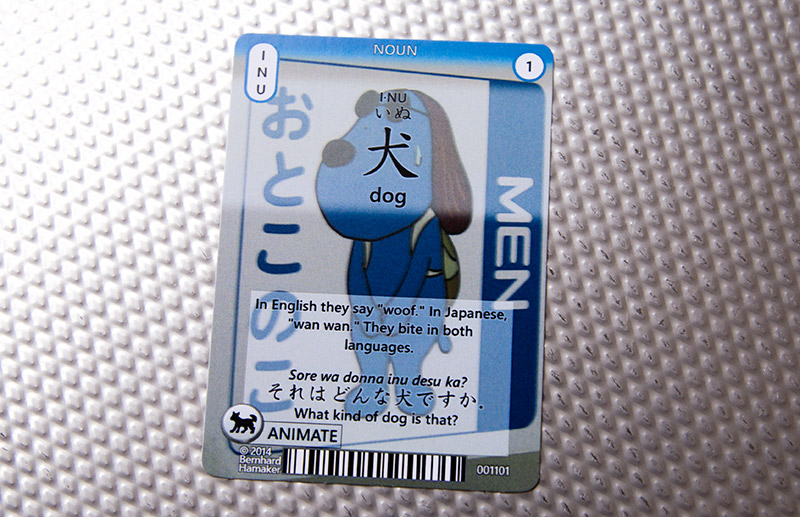
The cards themselves are also problematic. They contain all the information needed to learn and play the game, but in a visual format that is not conducive to understanding the content. I really like the color-coding concept and the idea of visualizing parts of speech as different colors, but there are too many parts of speech and not enough colors. Thus it becomes difficult to distinguish at a glance pairs like verbs (red) and the copula (vermilion), and adjectives (purple) and adjectival nouns (indigo).
The card layout has design issues. The background of each card is a photo or picture. This is a good idea, in theory, because players get an image to help them remember the vocab they’re learning, which is great for visual learners (like me). However, the photos are dark and vary in color and brightness. All the text is black (also dark) making it hard to read. On top of this, there’s a lot of info piled onto each card. Placed on top of every photo is a part of speech, pronunciation, card name, point box, target word, furigana, meaning, explanation, example, bar code, card number, and at least one badge. With all this information, where does your eye go? Romaji.
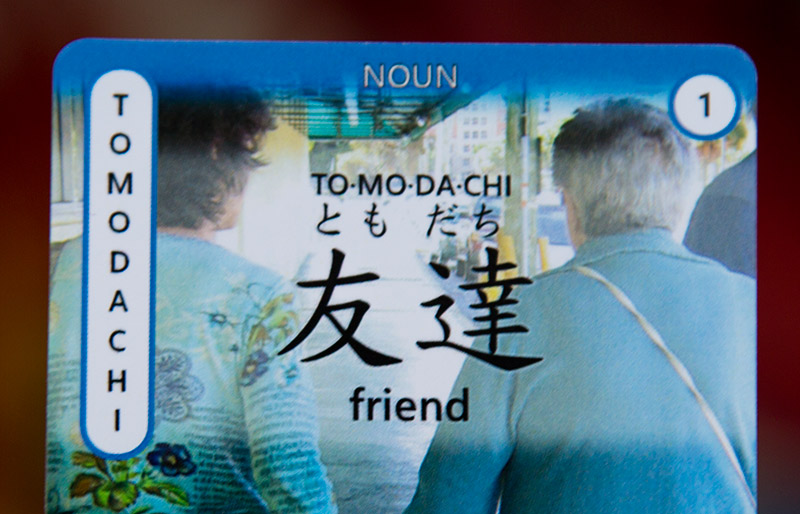
In the top left corner of each card is the card name, written in romaji against a white background. Not only is this the most easy-to-read and most eye-catching element of any card, this information is akin to the number and suit markings on a normal playing card. When holding cards, you want them arranged so this information is visible on each card in your hand. Like so:
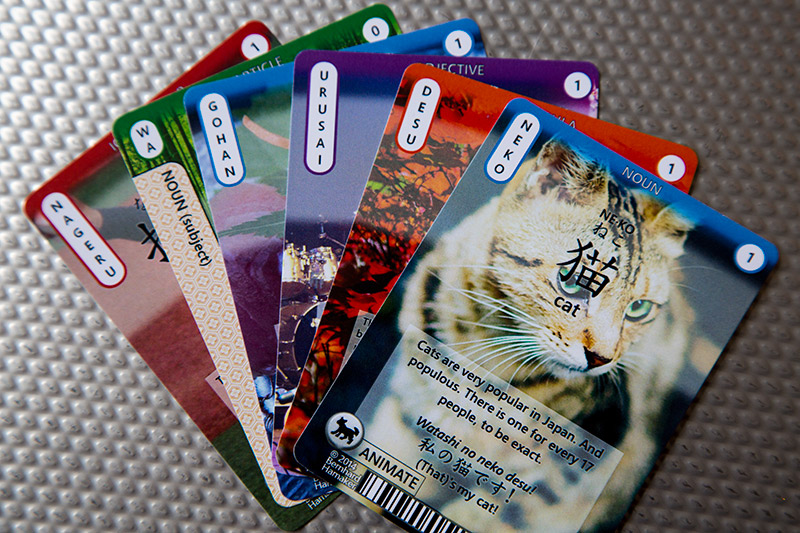
Thus, the information your eye will be going to the majority of the time is romaji, the type of Japanese writing you want to train your brain to forget, not remember.
Studying with JTG
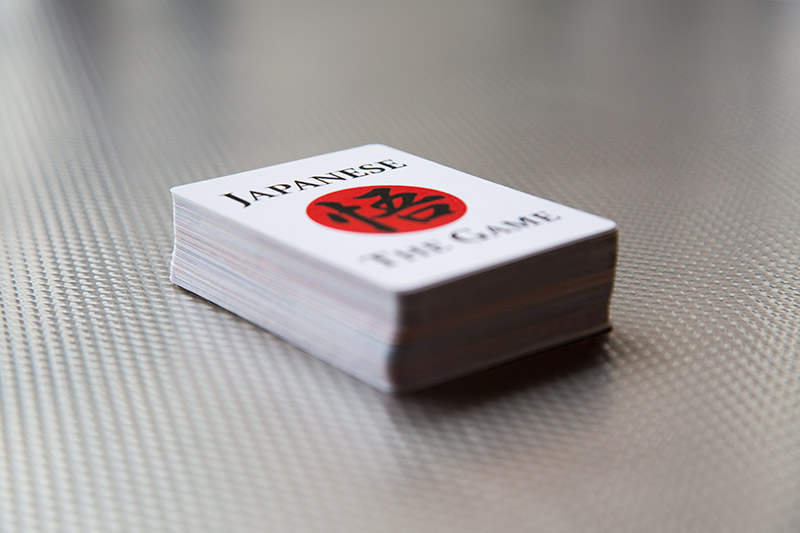
Game design issues are fine and all, but is it a good language learning tool? That largely depends on what aspect of Japanese you’re aiming to study.
I do like that JTG forces you to build your sentence around a predicate or what might be considered as the end of a sentence. This shakes up your brain and makes you actively build Japanese sentences from a perspective that is better suited to helping students wrap their heads around grammatical make-up.
If you’re looking to build your vocabulary, this is not the game for you. While I do really like the idea of attaching images to vocab, there’s just not enough vocab to learn. Considering there are 70 cards in the core deck, only 45 are words (not including particles). Assuming you know zero Japanese, that’s less than 50 words you’re going to learn while playing JTG. I guess the idea is that you need additional decks to learn additional words, but that’s an extra $20 you’re dropping for extra vocab you could add to an anki deck yourself for free. These same 45 words could be learned more easily in a week of anki sessions, thus allowing you to move on to 45 more.
For learning the ins and outs of grammar, JTG does a decent job at explaining the basics, but only if you read and re-read the rules to make sure you’ve got every detail down pat. This isn’t the fault of the game. It’s just the way language is. Languages have lots of rules, nuances, caveats, and exceptions. Trying to boil down all this into four pages and make it into a playable game is no easy task.
That said, all the time and effort needed to properly understand the rules before playing JTG would be better used simply studying with a good textbook. Studying is the only real way to make sure you learn the rules of language and understand them well enough to put them into practice.
Could one who already knows Japanese benefit from using JTG as practice? Possibly. The best way to use JTG, in my opinion, is without the rules in free play mode. Make all the cards available at once. Don’t take turns, draw cards, or keep score. Sit down at a table and start searching for words and building sentences based on your knowledge of Japanese. The cards are like building blocks you can use to express yourself. Playing this game according to the rules is like having an entire lego set and purposely limiting your available pieces to six at a time. So ditch the rules and use the cards to build sentences and have fun with the language.
Conclusion
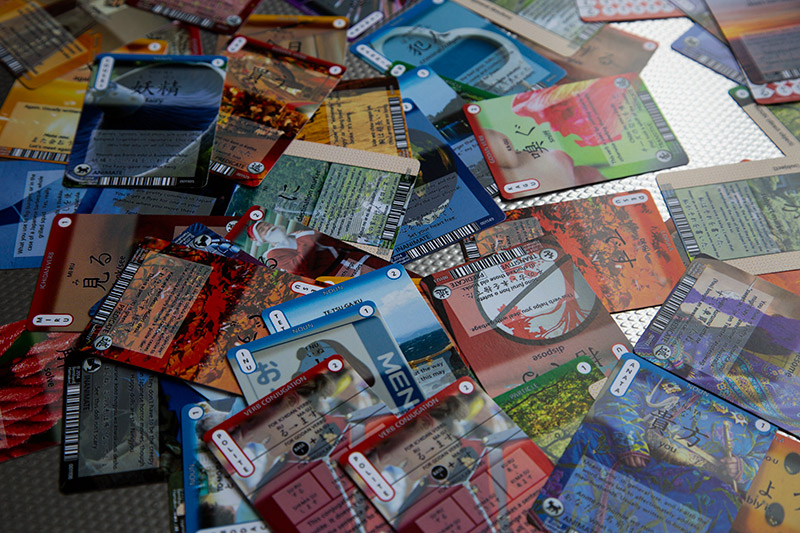
JTG is basically a color matching game, but even in following the colors, you are bound to the rules of the language which just can’t be explained well in this format. Building sentences around predicates and learning to connect parts of speech is a good idea. But the gamification and card layout make the experience frustrating and confusing. The game is still relatively new, so hopefully with some redesign, tweaking, and changes it can become the Japanese language learning game everyone is hoping for.
If you have this game, use it on your own terms. If you don’t, save your money and create your own cards. It will be cheaper and the process will teach you more than you could learn with JTG.
Kristen’s Review
If I could give this game a zero, I would. It’s a cash grab, and it’s scamming people into buying into a product that promises to teach them, but instead tricks them into feeling like they’re learning when they’re not.
Koichi’s Review
What an awful game. I often talk about products that “make you feel like you’re learning” but this is on another level. I don’t think it makes you feel like you’re learning at all, but the idea of “learning Japanese with a game” is so exciting that people bought it. Then they screwed over a bunch of their backers. I can’t recommend this at all.
Michael’s Review
You’re paying for what are essentially flashcards, and directions teach grammar concepts poorly or, worse, incorrectly. Sad to say, but playing this might actually hurt your Japanese ability. Avoid!
